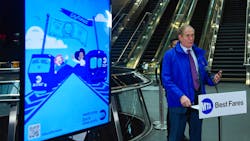MTA launches best fare initiatives to provide seamless, affordable travel throughout transit system
New expanded initiatives have commenced at the Metropolitan Transportation Authority (MTA) to promote best fare options for the most convenient and cost-effective journey for all riders.
First, the MTA relaunched and expanded CityTicket, which currently offers a $5 flat fare for rail travel within New York City on weekends. It will now be extended to all weekday off-peak trains. Additionally, a new 20-trip ticket will offer 20 percent off comparable to 20-peak one-way fares when purchased through MTA eTix or at a ticket window. These tickets are valid for 60 days. Monthly tickets, which are currently discounted between 48 percent and 61 percent off comparable peak tickets, will be discounted by an additional 10 percent.
“This is all about winning riders back to the MTA system,” said MTA Chair and CEO Janno Lieber. “I’ve made it a priority to get creative on fares. A big part of that is giving customers the best deal for their money. The new 20-trip ticket option was created this specifically for the rider who might be coming into the office only a few times a week.”
The CityTicket pilot offers promotional fares designed to encourage railroad ridership within New York City. The reduced rate is a $2.25 or 31 percent discount from Metro-North Railroad’s (Metro-North) current weekday fare between the Bronx and Manhattan, which previously cost $7.25, and a $2.75 or 35 percent discount from the Long Island Rail Road’s (LIRR) current weekday fare between eastern Queens and Manhattan or Brooklyn, which previously cost $7.75. CityTickets must be purchased and activated before boarding the train. Fares purchased onboard for intracity travel will remain $14 for LIRR and $13 for Metro-North.
CityTicket is valid at the following LIRR stations: Atlantic Terminal, Auburndale, Bayside, Douglaston, East New York, Flushing-Main Street, Forest Hills, Hollis, Jamaica, Kew Gardens, Laurelton, Little Neck, Locust Manor, Mets-Willets Point, Murray Hill, Nostrand Avenue, Penn Station, Queens Village, Rosedale, St. Albans and Woodside. Eligible Metro-North stations include: Botanical Garden, Fordham, Grand Central Terminal, Harlem - 125th Street, Marble Hill, Melrose, Morris Heights, Riverdale, Sputyen Duyvil, Tremont, University Heights, Wakefield, Williamsbridge, Woodlawn and Yankees - E. 153rd Street.
The discounted fare packages take effect on Tuesday, Mar. 1, when peak fares return to the LIRR and Metro-North.
Fare calculator
To make it as easy as possible for LIRR and Metro-North customers to figure out which ticket is best for them, the MTA has launched a new fare calculator to help riders find the best monthly deal. Customers must enter their origin and destination stations in the calculator and how many rides they’ll need, and the calculator will display the best option for them.
“Customers debating which ticket is the most economical should use the newly launched fare calculator on our website to find the best deal,” said MTA Chief Customer Officer Sarah Meyer. “All customers need to do is enter their origin and destination stations and how many rides they’ll need, and the calculator will take care of the heavy lifting.”
Fare capping pilot for New York City Transit
As announced on Feb. 7, the MTA also launched a fare capping pilot on Feb. 28 to encourage New Yorkers to get back on subways and buses by reducing the cost of everyday travel. A key element of the promotion is the “Lucky 13” feature: every additional ride on subways and buses after the 13th trip will be free for the rest of that week.
The best weekly fare will be available to all riders who tap with OMNY, without the burden of pre-paying for the week or having to track their progress. OMNY’s technology provides enhanced flexibility to subway, local bus and Staten Island Railway customers, so they can start accumulating benefits weekly. Any customer with a device or contactless card can begin tapping their way to free rides if they use the same device or card each time. Customers who tap and go with OMNY will be charged the standard $2.75 pay-per-ride fare for their first 12 trips, starting every Monday. Any additional trips through the following Sunday would be free.
No OMNY customer would pay more than $33.00 per week, which is the current price of a seven-day unlimited-ride MetroCard. This way, customers receive the benefits of a seven-day unlimited-ride card without having to decide to pay in advance. Free transfers between subways and buses will continue to be offered to all customers under this pilot. Two-part trips that are linked by a free transfer between subway and bus are considered one trip toward the 12 needed to reach the free-fare threshold each week.
To assist customers that will be using OMNY for the first time, the authority will launch an OMNY help desk on the first day of the pilot. The help desk will be stationed at the Grand Central 4, 5, 6 subway entrance and open from 10:00 a.m. to 11:30 a.m. MTA Chief Customer Officer Sarah Meyer and customer service representatives will be available to answer any OMNY or fare-capping questions. To celebrate the launch, the New York Transit Museum will have pre-loaded OMNY cards available for a limited time at their Grand Central Terminal location. The cards are good for four trips.
Next steps
The MTA will evaluate the new fares’ impact on operations, the customer experience and farebox revenue. The pilot program is expected to last for at least four months. If the pilot proves successful, the new fare structures could be extended or become permanent.
